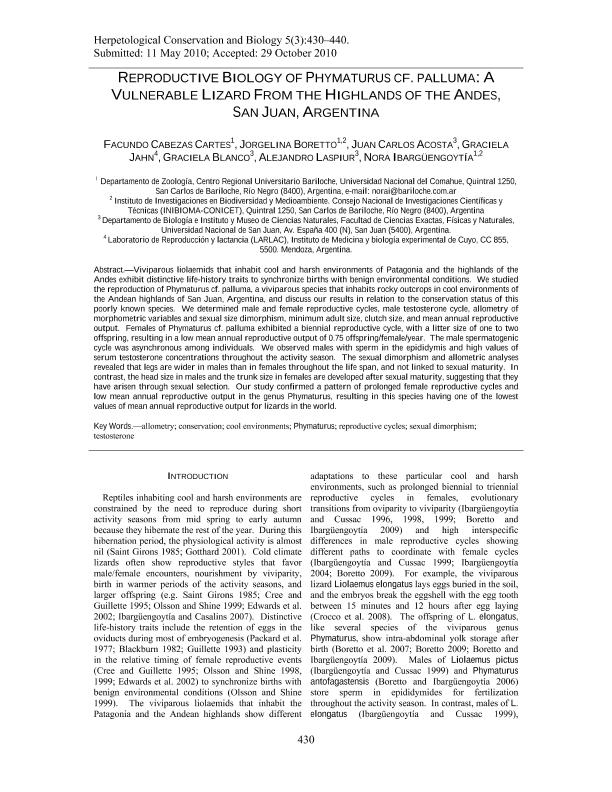Artículo
Reproductive Biology of Phymaturus cf. palluma An Endangered Species from Highlands of the Andes, San Juan, Argentina
Cabezas, Facundo ; Boretto, Jorgelina Mariela
; Boretto, Jorgelina Mariela ; Acosta, Juan Carlos; Jahn, Graciela Alma
; Acosta, Juan Carlos; Jahn, Graciela Alma ; Blanco, Graciela
; Blanco, Graciela ; Laspiur, Julio Alejandro
; Laspiur, Julio Alejandro ; Ibarguengoytía, Nora
; Ibarguengoytía, Nora
 ; Boretto, Jorgelina Mariela
; Boretto, Jorgelina Mariela ; Acosta, Juan Carlos; Jahn, Graciela Alma
; Acosta, Juan Carlos; Jahn, Graciela Alma ; Blanco, Graciela
; Blanco, Graciela ; Laspiur, Julio Alejandro
; Laspiur, Julio Alejandro ; Ibarguengoytía, Nora
; Ibarguengoytía, Nora
Fecha de publicación:
12/2010
Editorial:
Herpetological Conservation and Biology
Revista:
Herpetological Conservation and Biology
ISSN:
1931-7603
Idioma:
Inglés
Tipo de recurso:
Artículo publicado
Clasificación temática:
Resumen
Viviparous liolaemids that inhabit cool and harsh environments of Patagonia and the highlands of the Andes exhibit distinctive life-history traits to synchronize births with benign environmental conditions. We studied the reproduction of Phymaturus cf. palluma, a viviparous species that inhabits rocky outcrops in cool environments of the Andean highlands of San Juan, Argentina, and discuss our results in relation to the Conservation status of this poorly known species. We determined male and female reproductive cycles, male testosterone cycle, allometry of morphometric variables and sexual size dimorphism, minimum adult size, clutch size, and mean annual reproductive output. Females of Phymaturus cf. palluma exhibited a biennial reproductive cycle, with a litter size of one to two offspring, resulting in a low mean annual reproductive output of 0.75 offspring/female/year. The male spermatogenic cycle was asynchronous among individuals. We observed males with sperm in the epididymis and high values of serum testosterone concentrations throughout the activity season. The sexual dimorphism and allometric analyses revealed that legs are wider in males than in females throughout the life span, and not linked to sexual maturity. In contrast, the head size in males and the trunk size in females are developed after sexual maturity, suggesting that they have arisen through sexual selection. Our study confirmed a pattern of prolonged female reproductive cycles and low mean annual reproductive output in the genus Phymaturus, resulting in this species having one of the lowest values of mean annual reproductive output for lizards in the world.
Archivos asociados
Licencia
Identificadores
Colecciones
Articulos(CCT - SAN JUAN)
Articulos de CENTRO CIENTIFICO TECNOLOGICO CONICET - SAN JUAN
Articulos de CENTRO CIENTIFICO TECNOLOGICO CONICET - SAN JUAN
Articulos(INIBIOMA)
Articulos de INST. DE INVEST.EN BIODIVERSIDAD Y MEDIOAMBIENTE
Articulos de INST. DE INVEST.EN BIODIVERSIDAD Y MEDIOAMBIENTE
Citación
Cabezas, Facundo; Boretto, Jorgelina Mariela; Acosta, Juan Carlos; Jahn, Graciela Alma; Blanco, Graciela; et al.; Reproductive Biology of Phymaturus cf. palluma An Endangered Species from Highlands of the Andes, San Juan, Argentina; Herpetological Conservation and Biology; Herpetological Conservation and Biology; 5; 3; 12-2010; 430-440
Compartir



